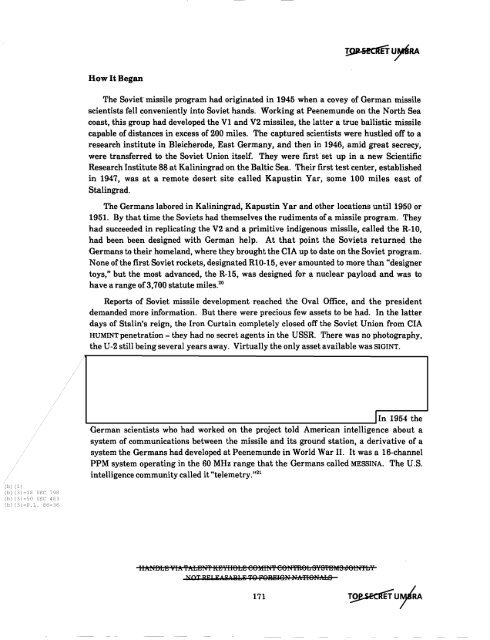American Cryptology during the Cold War - The Black Vault
American Cryptology during the Cold War - The Black Vault
American Cryptology during the Cold War - The Black Vault
Create successful ePaper yourself
Turn your PDF publications into a flip-book with our unique Google optimized e-Paper software.
HowItBegan<br />
<strong>The</strong> Soviet missile program had originated in 1945 when a covey of German missile<br />
scientists fell conveniently into Soviet hands. Working at Peenemunde on <strong>the</strong> North Sea<br />
coast, this group had developed <strong>the</strong> VI and V2 missiles, <strong>the</strong> latter a true ballistic missile<br />
capable of distances in excess of 200 miles. <strong>The</strong> captured scientists were hustled off to a<br />
research institute in Bleicherode, East Germany, and <strong>the</strong>n in 1946, amid great secrecy,<br />
were transferred to <strong>the</strong> Soviet Union itself. <strong>The</strong>y were first" set up in a new Scientific<br />
Research Institute 88 at Kaliningrad on <strong>the</strong> Baltic Sea. <strong>The</strong>ir first test center, established<br />
in 1947, was at a remote desert site called Kapustin Yar, some 100 miles east of<br />
Stalingrad.<br />
<strong>The</strong> Germans labored in Kaliningrad, Kapustin Yar and o<strong>the</strong>r locations until 1950 or<br />
1951. By that time <strong>the</strong> Soviets had <strong>the</strong>mselves <strong>the</strong> rudiments ofa missile program. <strong>The</strong>y<br />
had succeeded in replicating <strong>the</strong> V2 and a primitive indigenous missile, called <strong>the</strong> R-10,<br />
had been been designed with German help. At that point <strong>the</strong> Soviets returned <strong>the</strong><br />
Germans to <strong>the</strong>ir homeland, where <strong>the</strong>y brought <strong>the</strong> CIA up to date on <strong>the</strong> Soviet program.<br />
None of <strong>the</strong> first Soviet rockets, designated RIO-IS, ever amounted to more than "designer<br />
toys," but <strong>the</strong> most advanced, <strong>the</strong> R-15, was designed for a nuclear payload and was to<br />
have a range of3,700 statute miles. 20<br />
Reports of Soviet missile development reached <strong>the</strong> Oval Office, and <strong>the</strong> president<br />
demanded more information. But <strong>the</strong>re were precious few assets to be had. In <strong>the</strong> latter<br />
days of Stalin's reign, <strong>the</strong> Iron Curtain completely closed off <strong>the</strong> Soviet Union from CIA<br />
HUMINTpenetration - <strong>the</strong>y had no secret agents in <strong>the</strong> USSR. <strong>The</strong>re was no photography,<br />
<strong>the</strong> U-2 still being several years away. Virtually <strong>the</strong> only asset available was SIGINT.<br />
lIn 1954 <strong>the</strong><br />
"-----------------------------------'<br />
German scientists who had worked on <strong>the</strong> project told <strong>American</strong> intelligence about a<br />
system of communications between <strong>the</strong> missile and its ground station, a derivative of a<br />
system <strong>the</strong> Germans had developed at Peenemunde in World <strong>War</strong> II. It was a 16-channel<br />
PPM system o~erating in <strong>the</strong> 60 MHz range that <strong>the</strong> Germans called MESSINA. <strong>The</strong> U.S.<br />
intelligence community called it"telemetry."21<br />
11)<br />
Ib) (3) -18 USC 798<br />
Ib) (3) -50 USC 403<br />
Ib) (3) -P.L. 86-36<br />
lI:A:NBbB VIA 'f:A:bBN'f IEBYUSbB eSMIN'f eSN'fRSb S-YS'fBMS dSm'fLY<br />
NoT REI FA i A,QU TQ FQREIS?f ?M'fI8?MbS<br />
171
















